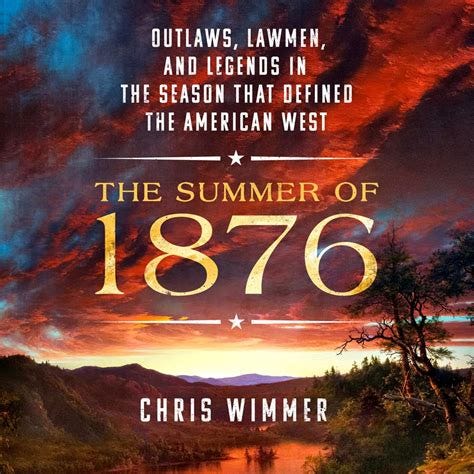Published just last year, The Summer of 1876: Outlaws, Lawmen, and Legends in the Season that Defined the American West, is a well-written, fast-moving wild wide through one of the wildest summers in American history.
Wimmer follows several stories that unfolded over that first centennial summer or the American Republic—the campaign that ended in the Battle of the Little Bighorn and Custer’s demise, the murder of Wild Bill Hickock at the Number 10 Saloon in Deadwood, South Dakota, the adventures of the James-Younger Gang culminating in their debacle in Northwood, Minnesota, the story of how Bat Masterson and Wyatt Earp laid down the law in Dodge City, Kansas, and the emergence of that great American pastime, professional baseball.
Nearly half the book focuses on the campaign to force the Sioux and Cheyenne onto reservations that summer in a brisk manner full of fun facts. He starts with Red Cloud concocting a clever strategy to force the whites to sign a treaty in 1868 granting the Sioux the Black Hills of South Dakota and a good chunk of Montana, tells of the discovery of gold in them thar hills when the federal government desperately needed more of it after the Panic of 1873, of President Grant’s reluctance to give one George Armstrong Custer the command and glory he craved, of Custer’s insufferable ego and narcissism that led to his death, of the clever strategy of Sitting Bull, and the aftermath.
Wild Bill Hickock’s adventurous life is briefly described, and throughout the book Wimmer portrays a tired man, probably suffering from PTSD, made his way to Deadwood to seek his fortune only to be murdered by a quintessential loser.
Wimmer doesn’t have as much to say about Masterson and Earp, other than they kept the drunken Texas cowboys to a low roar and mostly unshot in Dodge.
The James Gang is followed in considerable, and interesting, detail, from their time as Confederate irregulars through their Missouri train robberies to the debacle in Minnesota, and brings the staid Minnesota farmers, mostly German and Scandinavian stock who effectively stood up to them, to life.
The story of the gang’s retreat from Northfield, the capture of some, the escape of the James brothers, and their ultimate fate is written well enough to inspire some sympathy for the devils of the time.
What I liked most was the way Wimmer brought out the humanity of most of these characters, and how he thoroughly immerses both himself and the reader into the material conditions of the time and how those shaped the human beings who lived in it.
If you want a quick, fun read about one of the most interesting summers in American history, this is a great book for you.
**********************************************************************
All my posts are free, but I am a working class American staring into the scary financial abyss of retirement, so if you enjoy my work, please consider a paid subscription or a one time donation by buying me a beer.






Thank you for sharing another most interesting book a companion to your most interesting suggestion on the works about pirates - both of which I have savored......This particular work and the topic of the last 'major' Indian War evokes an eventful antecedent about U.S. Grant....He had much experience prior to the American Civil War in his experiences with the War with Mexico, where many of his Civil War colleagues honed their sabers. I think Grant's reflections on that war are noteworthy in that he thought the goals were to expand slavery.....Don't know if he pondered that much about the Indian wars - they were omitted in his memoirs...The aftermath of the The Little Big Horn battle saw the Indians removal in the late 1870's to what became my hometown in Ponca City, OK....But Chief Standing Bear lead the tribe south and his son (+) perished along the way with the request that his body be returned and buried in his homeland...The Poncas compliance with the request led the Indians to return to Nebraska and President Hayes assigned the U.S. calvary to forcibly removed them, an episode establishing the landmark USSC determination (1879) of whether or not Indians were 'legally' persons and had the right to habeus corpus...Standing Bear statues, memorials are throughout the US to include my hometown which has a park/statue in his honor and also the US Capitol.
1876 was one helluva summer! Sounds like a good read for armchair historians.